By Simon Batterbury
South East Australia is currently (February 2020) dry, hot, and burning. This is not unusual, but this year it is different.
Don Garden, an Australian environmental historian and a former colleague of mine, related how, on moving from Melbourne to Mount Macedon not far outside the city in 1983, he suffered an abrupt introduction to fire risk in rural Australia. He and his family had to relocate and then lost all their possessions in two major bushfires that occurred in quick succession (and, painful for him and for any academics reading this, he also lost two nearly-complete book manuscripts!) (Garden 2009). He had been through what became known as the Ash Wednesday fires, which burned about 12,000 km2 in Victoria and South Australia and took 75 lives. The majority of fires occurred in a matter of hours, when high temperatures combined with wind speeds up to 110 km/h. They became infamous in discussions of managing bushfire emergencies and resulted in changes to management strategies and building codes at federal and state level (for example, more maintenance of high tension electricity pylons, better communication systems for country fire services, and investment in better weather forecasting).
Again in February 2009, I was with my family, safe in inner city Melbourne when unknown to us, east of us bushfires raged, in temperatures up to 46 °C with 100 km/h winds. These Black Saturday fires were ignited by a downed power line, an electrical fault, and a cigarette butt. Some 450,000 hectares burned, 173 lives were lost, and 3,500 buildings destroyed. There was a Royal Commission of Inquiry, power line failures were found to be the main ignition source, and out-of-court settlements were made by an electricity company that admitted errors. The entire township of Maryville was destroyed. Also, a later scientific study showed anthropogenic climate change had increased the likelihood of elevated wildfire risk over southeast Australia during this 2008-2009 fire season through temperature increase, El Niño–Southern Oscillations (ENSO) led to drought and decreased humidity (Black 2016).
Fires occur annually in Australia. Examples include those in Queensland in 2018 and New South Wales in 2013-14 (Wilkinson and Erikson 2015). In each case, emergency management procedures and regulations are reviewed to at least minimize the risk to life (in New South Wales to enable bush clearing around dwellings, reducing tree cover – a controversial policy, Salgo and Gillespie 2018).
But 2019 was Australia’s hottest and driest year since records began (Bureau of Meteorology, 2020). From November 2019 and into January 2020 we have experienced fires of a different magnitude. There have already been almost 40 lives lost, 6,000 properties burned to the ground, and an area larger than England and Wales has burned across four states (18.6 million hectares so far)– with smaller fires elsewhere, currently spreading south of Canberra in the Australian Capital Territory (ACT). The effect on biodiversity, habitat, and wildlife is incalculable – much of the area is forested or has different types of eucalypt ‘bush’ (dry eucalypts burn vigorously, although they regenerate if the fire is not too hot, and falling branches and even exploding trunks spread embers further).
There is continuing risk and trauma: bushfire seasons usually go on until March, the end of the Australian summer, with some current fires not yet controlled, and others bound to start (most often from dry lightning, but accidental or deliberate ignition cannot be ruled out). Towns and rural properties are still threatened, and evacuations are underway, particular prior to predicted hot or windy days. With climate change and teleconnections to global ENSO and other climate signals including the Indian Ocean Dipole (IOD), prediction of fire risk can be inexact, even in a county with good meteorologists and weather data.
The ecology of Southeast Australia requires fire, and plants and animals have co-evolved with it (Gergis 2018). Nonetheless, this year’s fires are the worst, in terms of heat and spatial extent, since European colonization in the late 1700s. Driving through the smoke and seeing some families emerging from the heavily affected and lethal fires in the Australian Snowy mountains and South Coast of New South Wales a month ago, the magnitude of the crisis really hit home. This is a short-term, but a recurring disaster set on a continent prone to enduring hazardous climatic conditions.
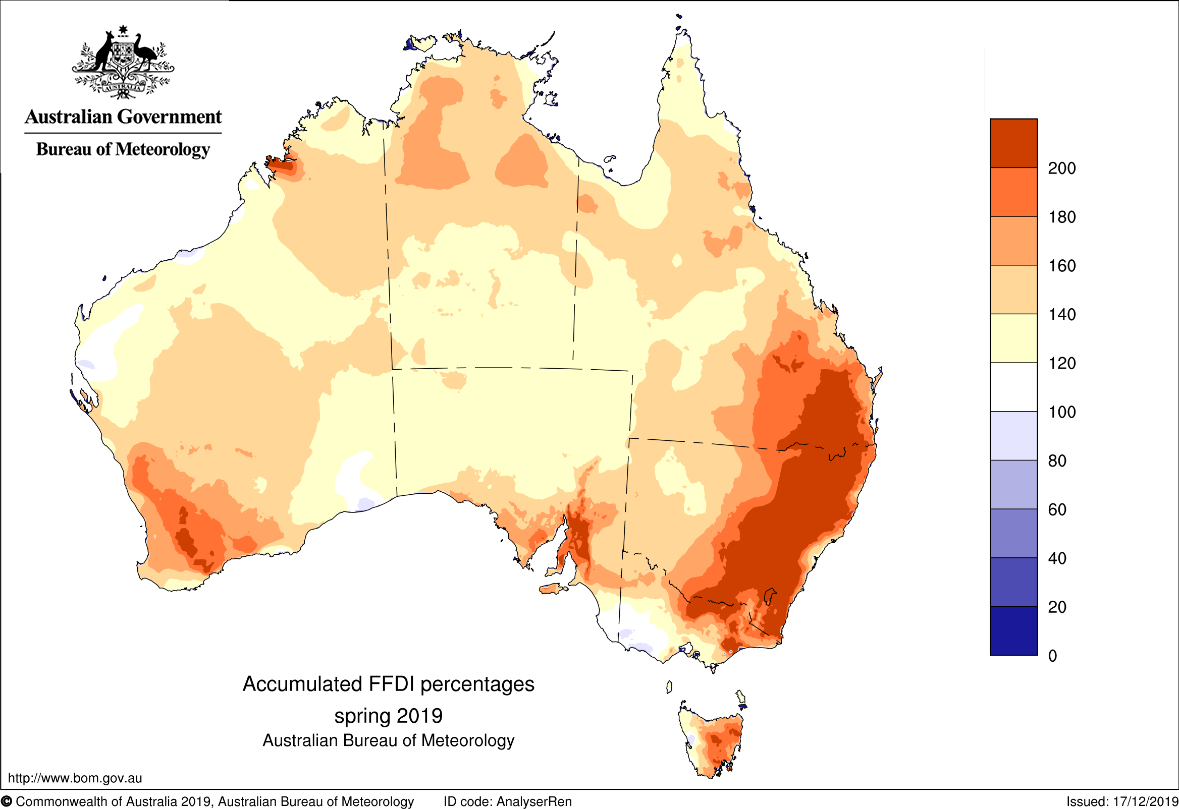
Accumulated Forest Fire Danger Index (FFDI) percentages, Spring 2019. The image shows areas of Australia’s east coast, Kangaroo Island and parts of Western Australia with higher than normal Forest Fire Danger Index (FFDI) due to a number of abnormal climate conditions. Source: Australian Bureau of Meteorology.
In the early stages of the crisis, as tourists and residents were fleeing the south coast of New South Wales or blockaded on beaches and next to water, it began to seem like a real climate emergency. We have seen pyrocumulonimbus or fire tornado events, caused by rapidly rising air. The public broadcaster ABC switched over to detailed emergency announcements with urgent orders to leave certain areas immediately (these broadcasts are mandated by law – if the cellular network drops and there is no electricity, a battery or vehicle radio may be all people can receive).
A part of this emergency, for many Australians, was that our federal politicians had not done enough to prepare for it, or to respond to it, despite persistent warnings since August 2019 that the fire index was going to be very high this summer. December then had the highest Forest Fire Danger Index (FFDI) since 1950 (the McArthur FFDI describes risk from fire, and comprises weather patterns, windspeeds, rain patterns and moisture content of vegetation). They have now responded, but the delays were inexplicable. The Prime Minister Scott Morrison, head of the political conservative Liberal Party (supporters of the free market, and with some exceptions, not averse to supersized fossil fuel extractive projects) was photographed on a beach in Hawaii as bushfires raged. He cut short his family holiday and returned home, but to large protests calling for his resignation. Rural fires services, which in Australia are called by different names in different states and include a mix of paid staff and trained community volunteers, were already under strain.
Since then, the world has watched as Australia burns. Smoke plumes reached New Zealand. Koalas perished. There have been agonising scenes of the families sheltering on beaches encircled by a red sky and thick smoke, and exhausted fire crews. The loss of wildlife and habitat is incalculable and ongoing. The federal government in Canberra took some days for the pro-coal, usually jovial but hard-edged Prime Minister to make a grudging acknowledgement that climate change is real, following his comments of 19 Nov 2019, against scientific advice and the feelings of 23 fire chiefs, that there were no links to emissions and that the government was ready. He outlined emergency spending plans, with the focus placed squarely on apolitical responses to a so-called ‘natural’ hazard – boosting our adaptation capacity and resilience, and reducing biomass fuel loads. The government pledged $A2bn on the 6th of January to support the victims, including support for businesses, rebuilding efforts and trauma counselling, and made some payments to volunteer fire crews. Quite how this will reach the affected parties is not yet clear. So far there has been nothing about Australia making real emissions cuts, even as a gesture to fire-affected Australians, the international community, and its critics.
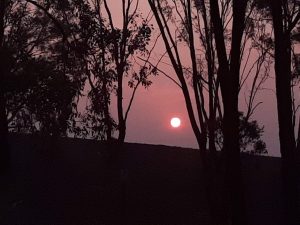
By James Batterbury. Dusk at Wangaratta, early January 2020.
The army has been called in and continues to evacuate coastal communities and holidaymakers, and Australia’s largest naval ship was repurposed as a medical centre and evacuation craft and deployed to Eden on the south coast of New South Wales with much needed supplies, including water. It was stationed close to a controversial mill, supplying paper pulp to Nippon Paper in Japan, which was destroyed (it was also the town’s largest employer). People are displaced, or homeless across several hundred kilometers and businesses, particularly those reliant on tourism in the peak of their season, are failing. Food supply chains are unstable but coping; there are worries over electricity supply and water provision. State governments have stepped up with rapid action from their emergency teams, and citizens have pledged millions of dollars for relief campaigns and offers of goods and temporary accommodation. Highways will be closed for weeks and whole towns like Malacoota, normally a tranquil fishing village and holiday destination halfway between Sydney and Melbourne, have been evacuated by sea and air. Malacoota’s only access road, and the Princes Highway to which it connects along a coastal route, were both closed with downed and unstable trees alongside melted tarmac. The Army is using armoured vehicles that can resist a falling tree, to remove debris from the road before it reopens in two weeks or so.
Viewed from North America or Europe, or indeed from the fire front, this seems like a disaster of enormous proportions, and a harbinger of a climate ‘tipping point’ – with escalating temperatures and fire occurring after a long drought suffered in parts of the interior (in part due to ENSO fluctuations and other climatic phenomena. detailed at https://australianbushfiresandclimatechange.com/). Were it not for the fact that Australia is an affluent democracy with vast mineral reserves, abundant farmland, and a relatively low population density in rural areas in the south east (only a small proportion of which are affected by fire– many more inhaled the smoke, though), the situation could be much worse. Preparedness since previous disasters means no rural settlement or household is without an evacuation plan. Some remote houses already have concrete bunkers complete with oxygen supply, and rooftop and wall sprinkler systems fed by tanks and pumps are common for ‘stay and defend’ operations, although with the intensity of the recent fires, many have actually failed. Finding money for these measures and for insurance is often a problem for preparedness (Wilkinson & Eriksen 2015). A lot of affected towns in mountainous terrain or by the coast have limited access and escape routes but so far, emergency and evacuation plans have been heeded – by people who congregated in urban areas like Albury-Wodonga and Wangaratta when told to leave the fire danger zone.
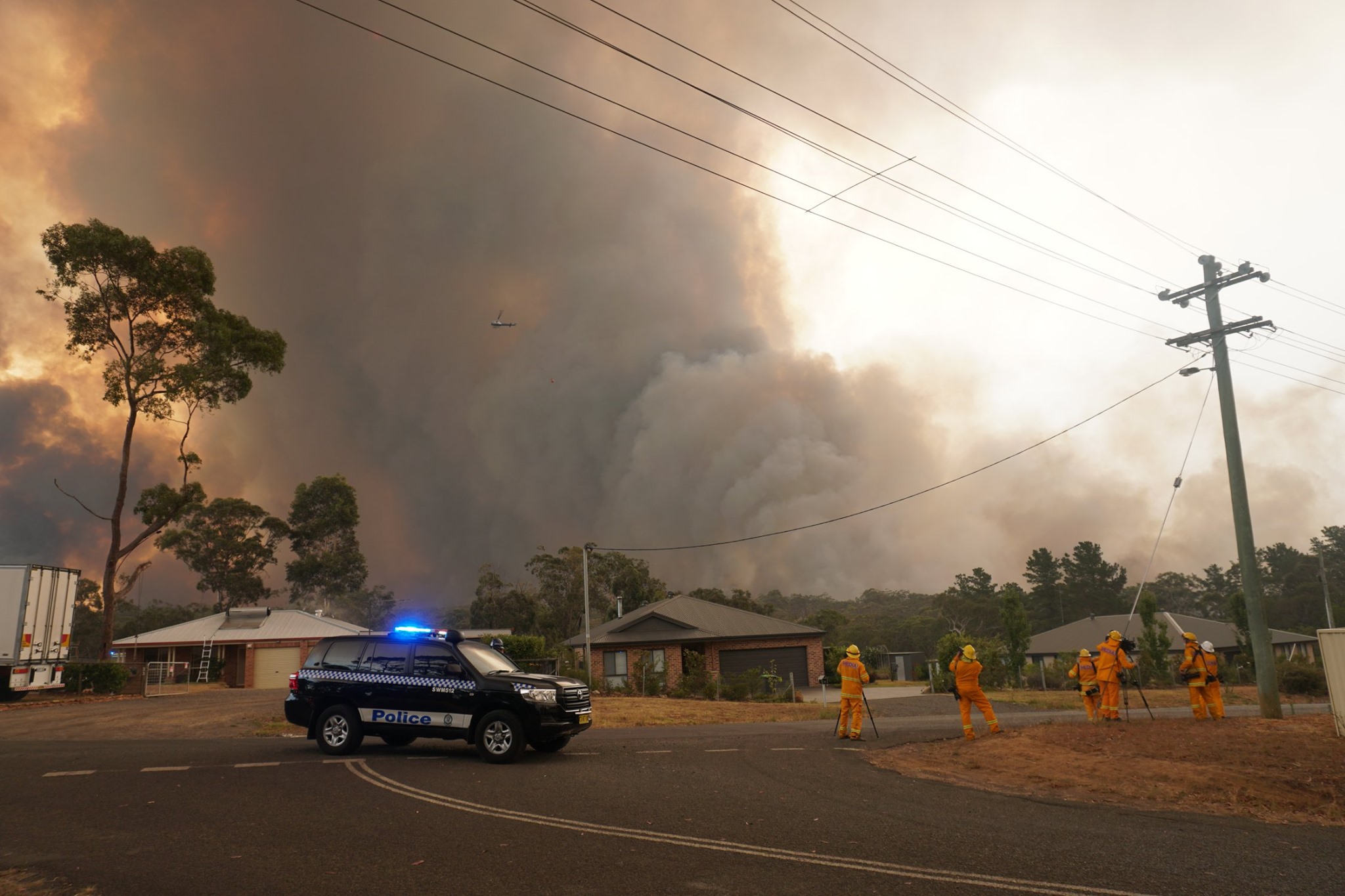
Large out-of-control bushfire approaches the New South Wales township of Yanderra. 21 December 2019. By Helitak430 – Own work, CC BY-SA 4.0, https://commons.wikimedia.org/w/index.php?curid=85436323
There are several lessons emerging from a political ecological analysis of this bushfire disaster.
1) Learning from the past
Aboriginal peoples have occupied the land now burning for at least 60,000 years, long before the first tentative British settlement and expansion from Sydney to Tasmania, South Australia and Victoria from the late 1700s. Countless generations of Indigenous peoples have actively managed fire as part of the annual cycle of natural and cultural events, and their voices are beginning to be heard (Head et al 2014). Fire was managed through traditional methods by nomadic or semi-nomadic populations, burning during winter months to keep ‘country’ healthy, to release nutrients and to promote the grasses favoured by local marsupials that were then hunted, and in some places to clear land for localized planting of native domesticated grains (Pascoe 2014).
There have been several appeals in the last few weeks to reinstate indigenous land management regimes and ‘cool burns’ as preventive measures on a large scale, to avoid the raging bushfires we see today. But cultural burning practices are now rare in South East Australia, knowledge has been lost, and much land is now in private hands or managed by the state (‘fuel load reduction burns’ do occur, led by trained government staff). Certainly, bush regeneration needs to happen first before cultural burning (widespread in the tropical north of Australia) could be reestablished, and remaining unburned forest areas will need intense management to harbour remaining wildlife populations, particularly threatened species like marsupial rodents, birds and reptiles (koalas, more in the media because they are cuter, exist across the continent and are not in danger of extinction).
Experts like Prof. David Bowman, University of Tasmania have argued there are synergies with scientific fire management, which assesses fuel load and quantitative risk. Cultural burning, he argues, is “an emotional relationship you have with land using fire to create mosaics and flammable habitat mosaics, which are really good for biodiversity and a really good way of managing fuel load.”
2) Poor policy on emissions is elided with fire emergency management.
Recriminations have begun, suggesting that Federal government actions in the face of fire were not rapid enough; fuel load (the amount of flammable biomass) in forested areas and national parks was too high; money for firefighting was not adequate, etc. Australians are good at pointing out the deficiencies of their governments, and in this case organisations like GetUp and Extinction Rebellion have claimed for some time that the current Liberal and National Party goverment is not sold on extensive carbon emissions mitigation, and indeed is still supporting an enormous carbon intensive project, the Carmichael Adani mine in Qld and this is a symbol of its disdain for good science and the environmental protesters. The fires have for many proven the folly of ineffective climate policy, forcing a government response and partial climbdown in the last few weeks. But of course, seasonal bushfires are difficult to link to global warming, with just enough debate to allow denialists a platform, despite the clear temperature and rainfall signals that have been predicted by climate scientists. The reality is that Australia’s contribution to global climatic change is small, but significant, and extremely high per capita. While it is natural to link the bushfire crisis with Australian emissions policy, they really require separate and better targeted campaigns while this emergency is on. We wait to see if a feedback loop will now increase public protest and interest in lower carbon emissions for households and the nation – given the ‘tipping point’ that the current emergency signals.
3) Apocalyptic imagery
While the affected region has attracted millions of dollars in donations from celebrities out-pledging each other and firms (some, big emitters) to support bushfire rebuilding and wildlife support, and almost every person who contacted me from overseas wants to know if we are safe, the mainstream media has focused on presenting catastrophe. Some imagery is used to castigate alleged arsonists, and environmentalists that allegedly favour wilderness preservation but therefore allowing ‘fuel load buildup’. This is the Australian equivalent of blaming smallholders in Africa or Asia for local environmental degradation – while the real culprits, engaging in agribusiness and land grabs, are more powerful, and elsewhere. This sort of narrative is pursued by news outlets that try to minimise the link to global climate change and carbon intensive electricity generation and resource extraction, as has occurred in the Newscorp Murdoch press (dominant in Australia). Other more progressive reporters try to sensationalise the link between slow action on global emissions in Australia and fire outbreaks (point 2 above) – this is popular with a different readership and viewers, and in terms of scientific veracity, can be difficult to show (see below). An example is the UK Channel 4 documentary, Australia on Fire: Climate Emergency (aired 4 Feb 2020) which focused on the disconnect between Canberra politics and fire victims. There is definitely a powerful Foucauldian discourse in some media that is abused to present and favour vested interests in Australia (particularly by news outlets supporting the status quo), and it needs to be challenged, rendered more detailed, and empirically linked to environmental and bushfire science. Bushfires can’t be morphed into post-truth factoids – their local impacts are real and as political ecology tells us, their drivers include global and national emissions and policies as well as local actions.
4) Multi level governance and the politics of blame
Building on this, Australian political debates over the environment are frustrating. They have been deeply polarized for decades, partly as a result of where, and how, people live and what they know and learn. There is a large resources sector with jobs reliant on extraction of minerals and timber, and substantial livestock and crop production, most of which is exported and which relies on sometimes scarce water. Meanwhile over 80% of Australians live in cities, many with far less knowledge of rural conditions and bushfires. This majority is politically polarized. ‘Discourse coalitions’ readily emerge, for example Green-friendly views in the city or in towns like Castlemaine and Byron Bay supporting anti-mining campaigns, particularly against Carmichael Adani at present, and swift climate action. But these are not widely shared across the continent. Frustratingly, at Federal level, most governments over the last 100 years have been to the political right (Liberal and National Party coalitions) and deeply resistant to stronger environmental regulations or climate action if they in any way affect jobs and businesses in the resources sector. Of course, they were elected by a voter majority, reflecting a polarized public, many of whom perceive radical policy change as too risky, or who are simply not politically engaged on the issues. The Lock the Gate films about coal seam gas protests exemplify some of these debates.
Scientific knowledge is enlisted strongly to support an environmental position, and warnings about biodiversity loss and extinctions from bushfires are just in their infancy, but will grow in 2020. A statement calling for action on emissions signed by over 260 scientists was just presented to the government and published (https://australianbushfiresandclimatechange.com/ ). Climate scientists in Australia receive negative press and abusive responses to their scientific work when it indicates warming trends or dangerous conditions. Former colleague and public scientist David Karoly related in 2018 how this happened to him. In addition, he shows that low probability, high consequence climatic events are the one to worry about now – and, that there is statistically significant risk, revealed through modelling, of higher summer temperatures in recent years (Lewis and Karoly 2013). He has now been proven dramatically correct in his observations. A lot more protest linked to these findings will occur locally, and with more consideration of emergency management in state and local governments. Some destroyed settlements could be abandoned. On-course for more dissent with the Federal government, the Victorian state government favours stronger climate action, despite having enough coal for 1000 years of electricity supply, and coal seam gas (which it has embargoed for now). Electricity production in Australia is overwhelmingly fossil-fuel generated and the biggest producer of CO2, and this is a large and growing flashpoint in politics.
Local government in Australia also has some authority to prepare for fires and hot days, and to support longer-term mitigation. Councils like Darebin (in Melbourne) where I live are very active – out of the path of bushfires but the world’s first local authority to declare a Climate Emergency, originator of a solar panel rebate scheme that has been widely praised, and led by a Green Party and Independent coalition supported by knowledgeable political-ecology qualified staff. Nonetheless, the extent to which political action even at this local level can influence individuals and households is probably overestimated. Australia is a capitalist economy in which many people aspire to an expensive and energy-inefficient property, to travel widely, and to engage in household consumption relatively cheaply and without much guilt. The political drivers for many citizens and residents is maintenance of lifestyle security, decent services, and lower taxation – not radical low-carbon downshifting and climate action.
5) Power to the environmentalists
The castigation of ‘environmentalists’ is a common theme under the current government and in certain regions and towns (rural electorates generally don’t vote Green or Labor). However in the cities, the Extinction Rebellion movement has grown considerably, and with its youth focus and name-and-shame policies, it could yet see some turnaround in general attitudes.
So-called environmentalists, or environmentally-conscious citizens, are the ones risking arrest on the front lines of protest against the massive extractive and resource projects that Australia favours, and they are also joining rural fire crews and supporting preventative burns in accordance with Indigenous practice. Reports by Cam Walker from Friends of the Earth, serving on a fire crew at Dinner Plain and Hotham (saved from the fires ) in the VIC Alps last month, illustrated this clearly.
Encouraging Australians to step off the consumption and production treadmill requires alternative life experiences, beginning in the formal education system (in which a few political ecologists sit). We need to do more; this is the biggest Climate Emergency of recent decades, even if the Federal government does not really recognize it as such (even the UK Government and its constituent elements have recognised a Climate Emergency and done far more to shift to renewables!). Everyday political ecologists and citizens are on the front line – Australia needs them to keep the pressure on. Degrowth narratives, even those with an Australian flavor (Alexander and Gleeson 2018), appeal to few, and the chain of causation linking individual consumption, electricity generation and energy use to heat, drought and bushfires is difficult to assemble and deploy.
6) The political ecology of the climate emergency
Lastly, we return to forefront the Climate Emergency. South Eastern Australia is in one. Soon, we are likely see our underfunded wildlife services and ecologists, point out that there have, indeed, been tragic wildlife extinctions this fire season. The problem in Australia is not, as D’Alisa notes on Undisciplined Environments in relation to Italy, that politicians seek profit from the declaration of a ‘climate emergency’ and exploit the terminology. It is that at Federal level in Australia, they refuse to acknowledge anything more than a temporary emergency driven by ‘natural’ events, and for which they therefore take no personal or institutional responsibility. This is replicated in the USA, as it actively dismantles environmental regulations, and the President talks of an ‘energy revolution’ still fueled by its fossil fuels.
For one of the world’s richest countries (in terms of GDP per capita, but also in its natural resource wealth and unique biodiversity) Australia must grapple with its millennial climatic tragedy. While, as I have said, I think we will all come to recognize the extent of this particular bushfire disaster in due course, as the toll mounts for wildlife and biodiversity losses. For many settlements, businesses, Indigenous communities and farmers, the heavy toll is already clear, financially and emotionally. Nobody wants it to happen again. The continent needs a combination of better preparedness, heeding Indigenous tradition and knowledge, pushing those in power to heed the gravity of the emergency, pulling back on fossil fuel exploitation and the hemorrhaging of poorly taxed corporate profits that results from it, and blaming the real culprits. For engaged political ecologists, we have work to do on all of these. We need Federal level recognition and full participation in strong international and national climate actions, assistance to affected communities and households from all three levels of government (with cautious rebuilding, listening to design professionals), listening to and acting with Australian youth who have had enough of climate inaction, and – for some I hope – heeding a degrowth agenda that will really challenge free market corporate greed, and perhaps hasten a sustainability transition (Alexander and Gleeson 2019). Teaching, better engagement (through advocacy and with activism and good research – Batterbury 2018), could be our own small contribution to a better climate and bushfire political ecology for Australia.
References
Alexander, S. and Gleeson, B. 2019 Degrowth in the Suburbs: A Radical Urban Imaginary. London: Palgrave.
Batterbury, S.P.J. 2018. “Affirmative and engaged political ecology: practical applications and participatory development actions”. Nordia Geographical Publications 47(5): 111-131. https://nordia.journal.fi/article/view/79938
Black, M.T. 2016. An attribution study of southeast Australian wildfire risk. PhD thesis. University of Melbourne.
Bureau of Meteorology. 2020 Annual climate statement 2019. http://www.bom.gov.au/climate/current/annual/aus/ .
Garden, D. 2009. Droughts, floods and cyclones: El Niños that shaped our colonial past. Melbourne: Australian Scholarly Publishing.
Gergis, J. 2018. Sunburnt Country: The History and Future of Climate Change in Australia. Melbourne: MUP Press.
Head L, M Adams, HV McGregor and S Toole. 2013. “Climate change and Australia”. WIRES Climate Change 5(2) 175-197 https://doi.org/10.1002/wcc.255
Lewis S.C. and D. Karoly. 2013. “Anthropogenic contributions to Australia’s record summer temperatures of 2013”. Geophysical Research Letters. 40(14): 3705-3709. https://doi.org/10.1002/grl.50673
Pascoe, B. 2014. Dark Emu. Broome: Magabala Books.
Salgo M. & J. Gillespie. 2018. “Cracking the Code: a legal geography and political ecological perspective on vegetation clearing regulations”. Australian Geographer 49:(4) 483-496, DOI: 10.1080/00049182.2018.1440688
Wilkinson, C. & C. Eriksen. 2015. “Fire, water and everyday life: bushfire and household defence in a changing climate”. Fire Safety Journal. 78: 102-110. https://scholars.uow.edu.au/display/publication103157
–
Simon Batterbury is Associate Professor of Environmental Studies at the University of Melbourne where he has taught since 2004, apart from an interlude as the inaugural Chair of Political Ecology at Lancaster University, 2017-2019. He has co-edited the Journal of Political Ecology since 2003, editing and publishing over 400 free OA articles on behalf on this community.


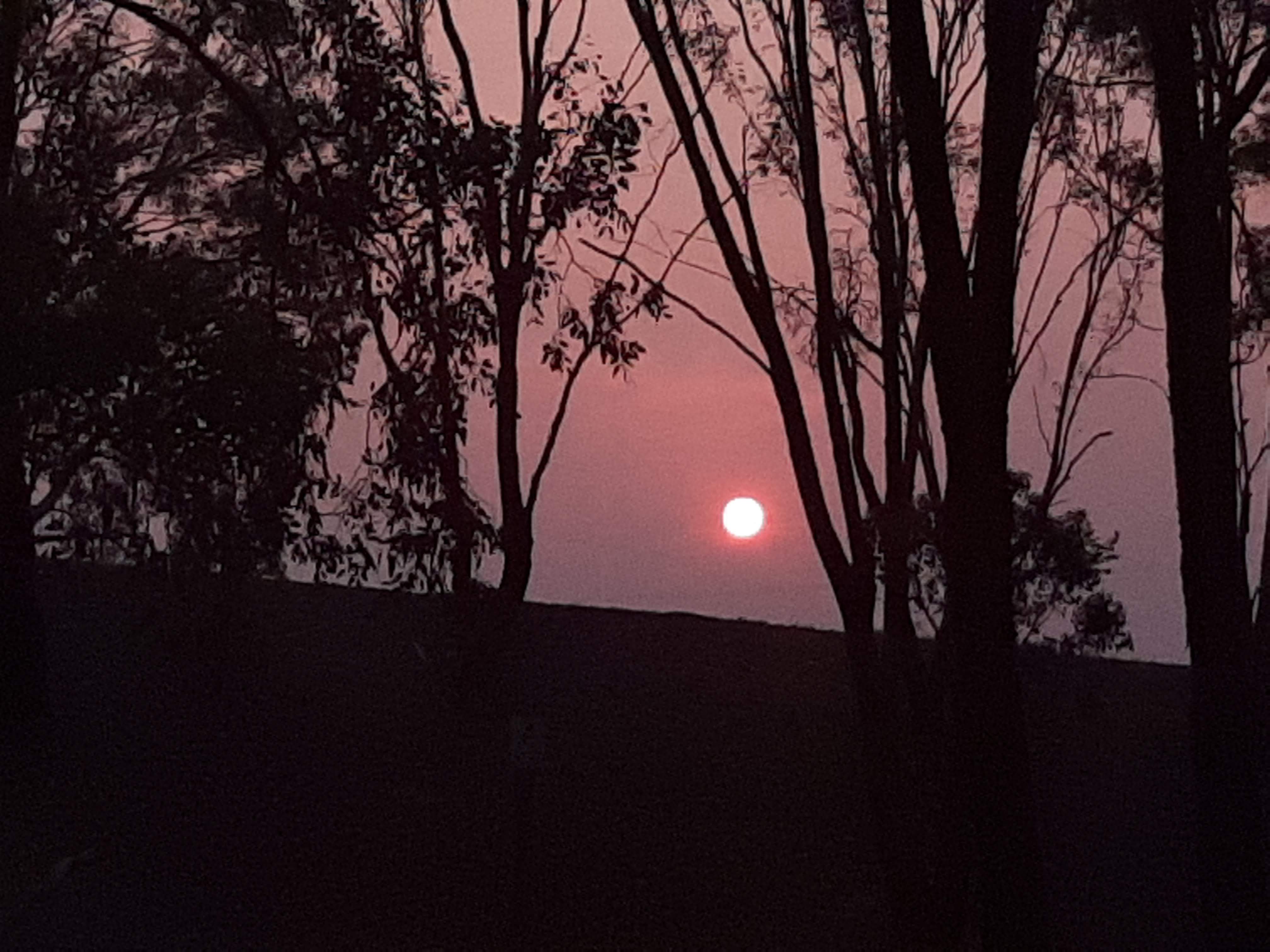

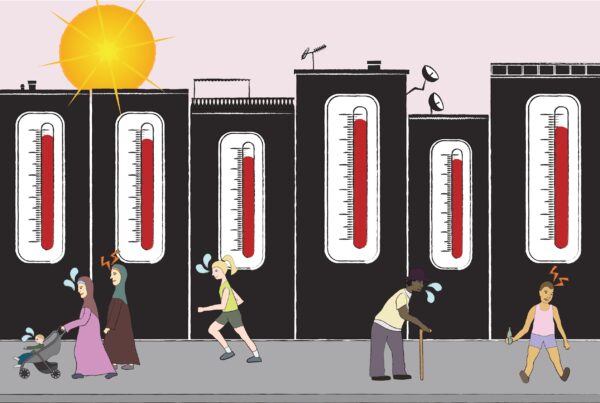
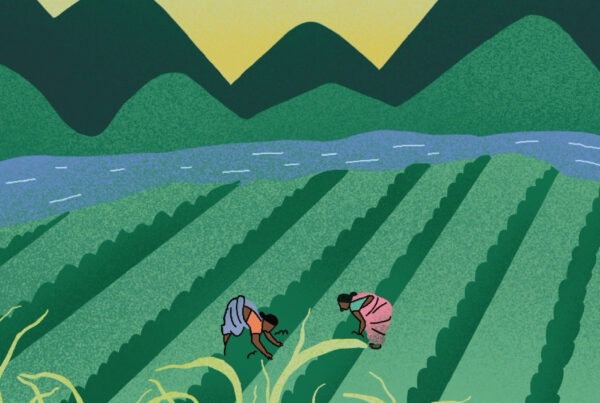
https://www.theguardian.com/australia-news/2020/mar/21/smoke-from-australias-bushfires-killed-far-more-people-than-the-fires-did-study-says
Nice thanks for the article